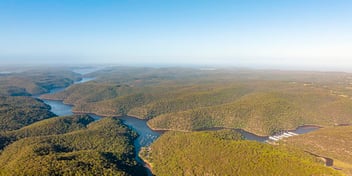Applying local interventions accelerates river recovery
Fencing off cattle from small sandy-based streams in southeast Australia is a crucial step in restoring waterways when catchment-wide erosion has slowed, a new study has found.
Alluvium Geomorphologist Alex Sims led a study into local waterway restoration interventions within a 30 km reach of the Bryan Creek, a tributary of the Glenelg River in southeast Australia, in partnership with the Glenelg Hopkins Management Authority and the University of Melbourne.
The study analysed the effects of the most common local restoration interventions once catchment-wide erosion has slowed, including extracting sediment directly from the streambed, replanting streambank vegetation and stock exclusion fencing, to learn more about what methods work best, and how the different interventions interact.
The research found that applying local interventions can be very effective in restoration efforts, but that excluding stock from stream banks is critical for natural water vegetation to reestablish, and more important than extracting sediments or revegetating stream banks.
Sims said that river recovery can be accelerated through local and targeted efforts – proving that activities commonly undertaken by river managers and community groups across Australia can dramatically improve river health.
“Up until now, most of the research has focused on how rivers begin to recover from the impacts of European arrival and the shift to agricultural land use in catchments of southeast Australia. But there has been less research on how river managers can intervene to help accelerate that process,” he said.
“A classic tenet in river rehabilitation, in terms of mitigating past disturbances, is that you have to treat the source of the problem, not the symptom. You have to treat erosion in the catchment before you treat the buildup of sand downstream.
“But what comes next? Once rivers begin to recover, can we go downstream and accelerate the recovery even more?”
“We found that if erosion has declined, due to intervention or naturally, doing something locally actually can be quite effective. The key thing in terms of this is excluding stock from the river so that vegetation can establish and the river can begin to heal.”
Historic intervention
Sims said the research project focused on the Bryan Creek catchment because the waterway has a history of restoration interventions, offering a strong case study for mitigation efforts.
“A lot of work has been done in the Bryan Creek catchment. We chose to focus on this waterway because it has had a lot of interventions applied to it in the past and we wanted to analyse the impacts and effects of these interventions,” he said.
“The interventions were applied by a number of people for a number of reasons. This is often the case in rivers. Sand extraction was performed at various times and locations in the river, for commercial reasons."
Sims said stock exclusion fencing had been erected at Bryan Creek in the early 1990s, too, but that the mitigation strategy often wasn’t maintained.
“At the same time as stock exclusion, there will often be vegetation planted. Some of that fencing was maintained, some of it was not. We often saw fencing at Bryan Creek that had been damaged and stock could access the riverbed anyway,” he said.
“This is a pretty classic scenario. Works will be applied to help the river, and then over time those interventions will lapse. Grants will be given to fund regeneration efforts, and then the efforts will be under-maintained and the problem begins again.”
Historical focus
The research project analysed historic data, considering how the riverbed had changed and the effects that localised interventions had on its health over time.
“Assessing the geomorphology of a 30 km reach, we looked at the environmental history of the area. We thought about what the river looked like before European settlement, how it changed afterwards, and how it changed leading up to our study,” Sims said.
“We used images, records of intervention from the past and channel surveys that were conducted at different times and places, in order to build a picture of how the river had changed.
“We also went out into the field to fill in the gaps where we could, to build a snapshot of what the river looks like now. This required field surveys, including drone photography, physical inspection of the banks, talking to landholders, as well as surveying of the river.
“We used a GPS to survey cross sections of the river to collect data on channel form and shape.”
Effective recovery
Sims said study outcomes showed that while revegetation and sediment removal have been a focus in the past, these efforts are ineffective if stock has access to the riverbed.
“Excluding stock from rivers allows vegetation to establish on the stream bed, and that vegetation establishment traps a lot of sediment, stops it from moving, and helps to create a much more complex bed, with deeper pools,” he said.
“This lockup of sand protects the base of the riverbed and the vegetation, and the river then uses its energy to scour the pools.
“While sand extraction can work, it’s only really effective if other mediation strategies are employed at the same time. Simply removing coarse sands from the river alone won’t help its health. You just end up with a different version of an unhealthy river.”
Sims said that while the study focused on Bryans Creek, the results can be reasonably applied to many waterways within south-east Australia, due to the general trend towards natural catchment recovery in those regions.
“The catchment recovery process has a natural trajectory, or change, over time. This broader pattern is true of much of the southeast of Australia,” he said.
“The issue is not unique to the catchment we worked within.”


